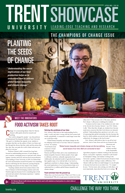A new study, co-authored by Trent University Biology professor Dr. Marguerite Xenopoulos, and published in the new issue of Nature Geoscience, has found that human disturbance to land is causing the release of “old carbon” into rivers and waterways, the negative effects of which are equated to the burning of fossil fuels.
“Soils store carbon over long periods of time. However, new research suggests that the effects of human land-use such as urban development and intensive agriculture and monocultures —are reducing how much carbon is stored in the ground,” explains Professor Xenopoulos. “When humans manipulate the land, the “old” stored soil carbon is released in nearby waterways, rivers and streams. The release of this aged carbon is comparable to the burning of fossil fuels.”
Prof. Xenopoulos co-authored the study with lead author Professor David Butman from the University of Washington, Professor Rebecca Barnes from Colorado College, Dr. Henry Wilson, a Trent University alumnus and current research scientist with Agriculture and Agri-Foods Canada, and Professor Peter Raymond from Yale University. Dr. Wilson completed his Ph.D. in the Watershed Ecosystems Graduate Program (now Environmental and Life Sciences) at Trent University in 2009.
The new paper in Nature Geoscience, called “Increased mobilization of aged carbon to rivers by human disturbance,” shows for the first time that the carbon in rivers with human affected land use (agriculture, urban) is aged (old), as determined through the use of carbon radioisotopes.
“Using data from southern Ontario coupled with a global dataset from field research around the world the study determined how carbon isotopes of organic matter in rivers can be linked to the impact of land disturbances—specifically, the release of 'old' previously stored carbon into the modern carbon cycle” says Prof. Xenopoulos. “Typically, in more pristine rivers most carbon would originate from newly formed and produced carbon from soils, and nearby plants and trees, but the results of this study suggest that up to nine percent of that organic carbon is actually aged carbon that human land disturbances have mixed back into the cycle.”
Through Professor Xenopoulos’ Natural Sciences and Engineering Research Council (NSERC) Discovery grant program, the study involved about a dozen river catchments in southern Ontario that span a gradient of agriculture land use.
Posted on Monday, December 22, 2014.


































